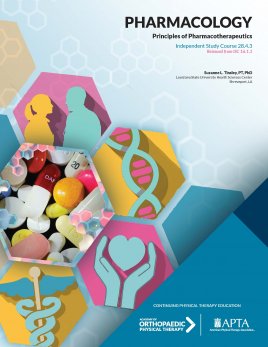
Principles of Pharmacotherapeutics & Pharmacology for Pain
| Online Only | |
|---|---|
| APTA Orthopedics Member | $35 |
| Non-APTA Orthopedics Member | $50 |
Note: CEUs are not offered for this course.
Course Description
This monograph covers the principles of pharmacotherapeutics that includes pharmacodynamics and pharmacokinetics. Dr. Tinsley first describes various aspects of pharmacodynamics including the following: mechanism of action and drug effects, drug receptors, agonists versus antagonists, the relationship between drug concentration or dose and clinical responses, dose-response curves, and adverse drug reactions. In the second part of the monograph, Dr. Tinsley discusses general considerations of pharmacokinetics including absorption, distribution, metabolism, biotransformation, half-life, and elimination. In addition, pertinent clinical implications are reviewed for pharmacodynamics and pharmacokinetics. Dr. Tinsley applies each topic by presenting case studies to enforce reader knowledge. This monograph is a wonderful introduction for those participants who may not be familiar with pharmacotherapeutics and also can serve as a comprehensive review for those who have previous education on the topic.
Course Overview
Course Format: Online
Course Objectives
Learning Objectives: Principles of Pharmacotherapeutics
Upon completion of this monograph, the course participant will be able to:
- Understand the general principles of pharmacology as they relate to clinical decision making in the physical therapy management of a patient.
- Be able to identify the important components of pharmacodynamic principles and how they may impact clinical outcomes in patients receiving physical therapy.
- Be able to identify the important components of pharmacotherapeutic principles as they relate to all populations and their impact on the physical therapy management of a patient.
Learning Objectives: Pharmacology for Pain
Upon completion of this monograph, the course participant will be able to:
- Review the primary pharmacokinetic and pharmacodynamic factors involved in drug therapy and understand important factors as they relate to classes of drugs used to control pain.
- Identify the general drugs classes, mechanisms of action, risk-benefit ratio, and implications on rehabilitative interventions for the pharmacological agents routinely prescribed for pain control.
- Through case studies identify the possible effects of drug therapy and various drug-drug interactions on the effectiveness of rehabilitative interventions and functional outcomes in the physical therapy client/patient.
Topics and Authors
Melissa Bednarek, PT, DPT, PhD, CCS
Add To Cart
Which version of the course would you like to purchase?
Members Only
You need to be a member to buy this course.
Join today to enjoy exclusive deals and prices on all courses.
Join Now